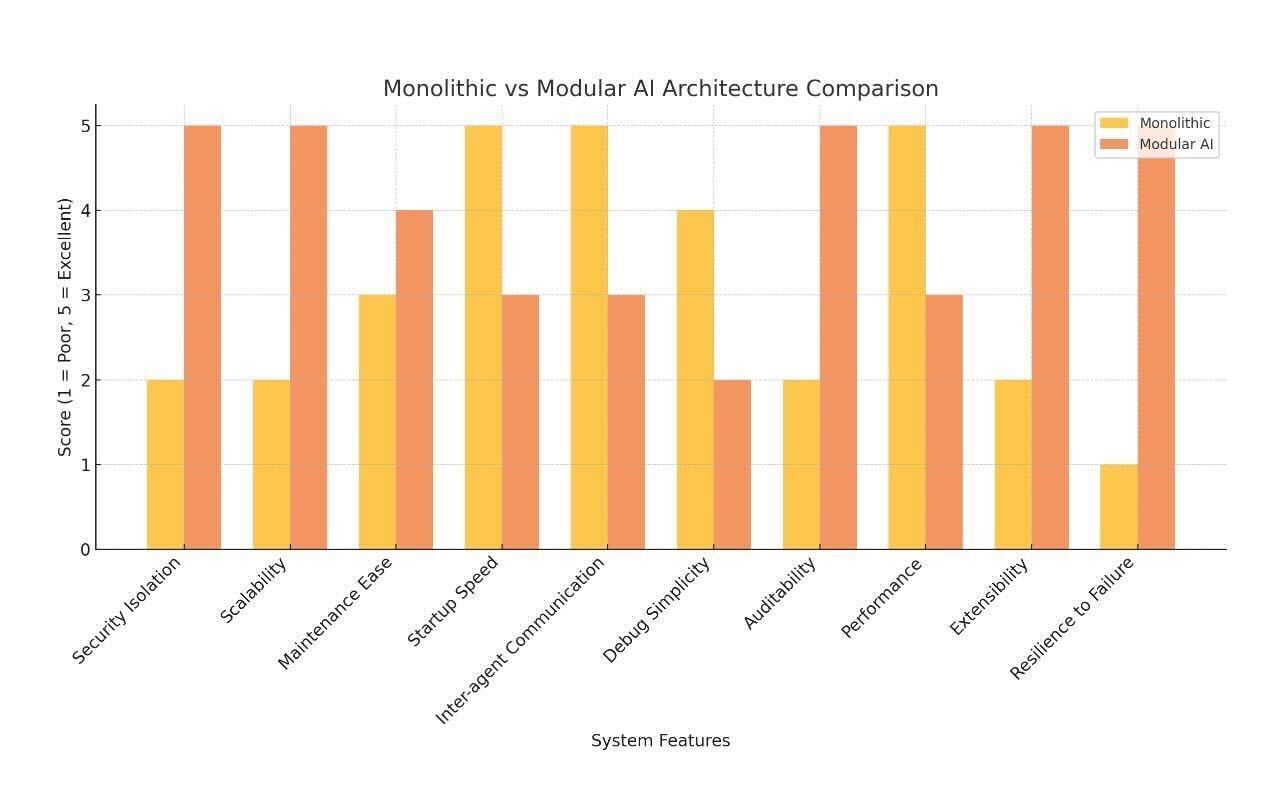Monolithic vs. Modular AI Architectures: The Battle for the Future of Intelligent Systems
May 9, 2024 | Author Jon Capriola, AI Blogger & Agentic Systems Advocate
⸻
In the rapidly evolving AI landscape, system architecture isn’t just a technical decision — it’s a security doctrine. As we build smarter, more connected AI agents, the way we design and deploy them will determine everything from scale and maintainability to user safety and trust.
Below, I break down the pros and cons of Monolithic vs. Modular AI Architecture, with a strong focus on what matters most: security.
⸻
Monolithic AI Architecture
All logic, models, tools, and data flows are tightly coupled into one large system.
Pros:
- Centralized Security Control: One entry point means fewer surfaces to defend (at least initially).
- Faster MVP Launch: Great for proof-of-concept stages; less overhead in deployment.
- Simpler Debugging (at small scale): Easier to trace issues when everything is in one place.
- Tightly Integrated Performance: No API handoffs = less latency.
- Reduced Deployment Complexity: Fewer moving parts, fewer deployment scripts.
Cons:
- Single Point of Failure: If one agent or subsystem is compromised, the entire system is at risk.
- Scaling is Painful: Tightly coupled components can’t be scaled independently.
- Limited Flexibility: Hard to add or remove features without breaking the whole.
- Security Silos: One bad actor agent can expose the entire memory bank if not sandboxed properly.
- Difficult to Audit: Logs and flows become entangled, making post-breach forensics harder.
Modular AI Architecture
AI systems are composed of isolated, plug-and-play agents with clear boundaries and communication protocols (like A2SPA).
Pros:
- Agent Isolation = Security Sandbox: If one module is compromised, others remain unaffected.
- Scalable by Design: Each module can be containerized, monitored, and scaled independently.
- Clearer Governance: Easier to assign roles, permissions, and audit logs per module.
- Rapid Innovation: Modules can evolve independently — update TravelMOD without touching FinanceMOD.
- Future-Proof with Blockchain/PKI: Modular systems can integrate decentralized ID verification and cryptographic signatures per agent.
Cons:
- Complex Coordination: Requires orchestration layers (like agent routers or secure APIs).
- Higher Initial Overhead: More setup for agent-to-agent protocols, access control, and secure communication.
- Versioning Hell if Unchecked: Without strict modular standards, drift occurs fast.
- Latency Between Modules: Communication can introduce delay if not optimized.
- Security Fragmentation Risk: Without unified observability, attackers might probe edge agents.
Why Security Is the Deciding Factor
As AI agents become autonomous, mobile, and collaborative, security among agents is no longer optional — it’s existential. Imagine:
• A FinanceMOD approving transactions because a compromised EmailMOD spoofed internal requests.
• A HealthMOD leaking private medical queries due to a misconfigured agent-to-agent token.
• An AI lawyer agent manipulated through adversarial prompts sent by a rogue ChatMOD embedded in another app.
These risks aren’t theoretical. Modular AI without secure inter-agent protocols is like a country without borders.
What the Future Demands: Modular + Secured by Design
The answer isn’t just “go modular.” It’s go modular with a protocol like A2SPA — where every agent signs its communication via PKI (Public Key Infrastructure), has Role-Based KPI Access, and is logged in real-time on a dashboard built for security observability.
This approach ensures:
• Only verified agents can speak to one another.
• Each agent is monitored by behavior thresholds.
• Security isn’t a bolt-on — it’s baked into the architecture from Day 1.
Final Thought:
As AI agents start negotiating deals, drafting legal docs, planning travel, and managing finances — your architecture isn’t just code. It’s governance. Make it modular. Make it secure. Or risk losing control of the very intelligence you built.

Here’s a visual comparison of Monolithic vs. Modular AI Architecture across 10 critical system features. As shown, modular AI architecture outperforms monolithic in key areas like security isolation, scalability, extensibility, and resilience to failure — making it the smarter long-term choice when agent-to-agent security and growth matter.
